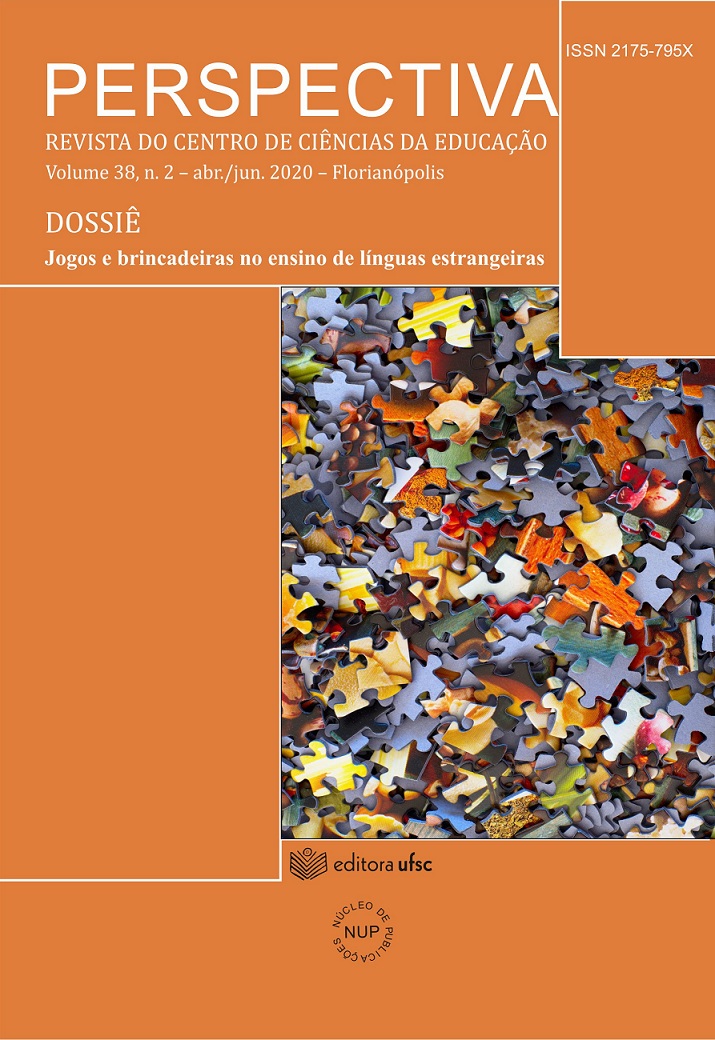Language games and movement games: ludic motion in Italian language classes
DOI:
https://doi.org/10.5007/2175-795X.2020.e66175Abstract
This study aims to share two ludic activities for Italian language teaching that can be adapted to other foreign language teaching contexts. The dynamics are mainly based on linguistic and movement games, which allow the student to move around the classroom, as in the oral development activity Caccia al tesoro (Treasure hunt). In this activity, the student is expected to move around the room to find out classmates who must meet the requirements made through a series of ludic and nonsense questions. Movement activities like that not only foster the use of spoken language and vocabulary acquisition, but also promote interaction and peer identification in the microuniverse of the classroom. The other activity, Il sasso nello stagno (The stone in the swamp), consists of the creative production of acrostics. Both ludic activities are designed to Middle School students and adults, and they are based on the premises of Gianni Rodari’s The Grammar of Fantasy (Grammatica della fantasia, 1973). Such activities are games that promote strangeness and creativeness. The students interact, think about the language, play and learn, and the class flows in a more spontaneous way.References
BALBONI Paolo Emilio; CAON, Fabio. La comunicazione interculturale. Venezia: Marsilio, 2015.
BUNN, Daniela. A imagem alimentar e o advento do menor na literatura infantil: estranhamentos de Gianni Rodari. Tese (Doutorado). Universidade Federal de Santa Catarina, Centro de Comunicação e Expressão, Programa de Pós-graduação em Literatura, Florianópolis, 2011.
BUNN, Daniela. Imagens de pensamento para a prática de mediação literária: o rizoma e a provocação dos sentidos. In: MARTINI, Marcus de; TRENTIN, Raquel; FELIPPE, Renata Farias de. (org.). Literatura na escola: teoria, prática e (in)disciplina. 1ª. ed. Santa Maria: UFSM, PPGL-Editores, 2016a, p. 203-212.
BUNN, Daniela. O alimento na literatura. Rafael Copetti Editor. São Paulo: 2016b.
DA MATTA, Roberto Augusto. Você tem Cultura? Suplemento Cultural do Jornal da Embratel, Rio de Janeiro, 1981. Disponível em: http://www.furb.br/2005/arquivos/788660-650601/voce%20tem%20cultura.pdf. Acesso em: jun. 2006.
DELEUZE, Gilles; GUATTARI, Félix. Mil Platôs: capitalismo e esquizofrenia. V. 2. reimpr. Trad. Ana de Oliveira e Lucia Leão. Rio de Janeiro: Editora 34, 2002.
GARCIA, Wladimir; SOUZA, Ana Claudia de. A produção de sentidos e o leitor: os caminhos da memória. Florianópolis: NUP/CED/UFSC, 2012.
HALL, Stuart. A identidade cultural na pós-modernidade. 6. ed. Trad. Tomaz Tadeu da Silva e Guacira Louro. Rio de Janeiro: DP&A, 2001.
ROCHA, Everardo. O que é Etnocentrismo. Ed. Brasiliense, 1984.
RODARI, Gianni. Grammatica della Fantasia. Torino: Einaudi, 1973.
RODARI, Gianni. Gramática da Fantasia. Trad. Antonio Negrini. São Paulo: Summus, 1982.
TORRESAN, Paolo. Pensiero divergente e didattica dell´italiano. In: Revista de Italianística. n. 21-22, p. 95-122, 2011. Disponível em: http://www.revistas.usp.br/italianistica/article/view/68612. Acesso em: 25 jun. 2019.
Downloads
Published
How to Cite
Issue
Section
License
This journal provides open access to all of it content on the principle that making research freely available to the public supports a greater global exchange of knowledge. Such access is associated with increased readership and increased citation of an author's work. For more information on this approach, see the Public Knowledge Project, which has designed this system to improve the scholarly and public quality of research, and which freely distributes the journal system as well as other software to support the open access publishing of scholarly resources. The names and email addresses entered in this journal site will be used exclusively for the stated purposes of this journal and will not be made available for any other purpose or to any other party.
The Perspectiva allow the author(s) yo hold the copyright without restrictions as well as publishing rights. If the paper will be republished later in another format, the author(s) should inform that it has originally been published as article in Perspectiva Journal and quote the complete references.



